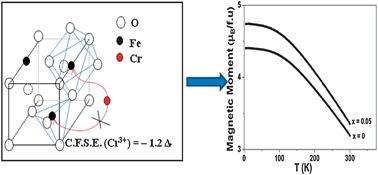Enhancement in the magnetic moment with Cr3+ doping and its effect on the magneto-structural properties of Ce0.1Y2.9Fe5O12
Abstract
A change in the overall magnetic moment of Cr3+ doped cubic garnet ferrites prepared by the modified sol–gel auto

* Corresponding authors
a
Department of Chemistry, Goa University, Goa 403206, India
E-mail:
sal_arun@rediffmail.com
Fax: +91-832-2452889
Tel: +92-832-6519315
A change in the overall magnetic moment of Cr3+ doped cubic garnet ferrites prepared by the modified sol–gel auto

 Please wait while we load your content...
Something went wrong. Try again?
Please wait while we load your content...
Something went wrong. Try again?
S. R. Naik and A. V. Salker, Phys. Chem. Chem. Phys., 2012, 14, 10032 DOI: 10.1039/C2CP41155E
To request permission to reproduce material from this article, please go to the Copyright Clearance Center request page.
If you are an author contributing to an RSC publication, you do not need to request permission provided correct acknowledgement is given.
If you are the author of this article, you do not need to request permission to reproduce figures and diagrams provided correct acknowledgement is given. If you want to reproduce the whole article in a third-party publication (excluding your thesis/dissertation for which permission is not required) please go to the Copyright Clearance Center request page.
Read more about how to correctly acknowledge RSC content.
 Fetching data from CrossRef.
Fetching data from CrossRef.
This may take some time to load.
Loading related content
